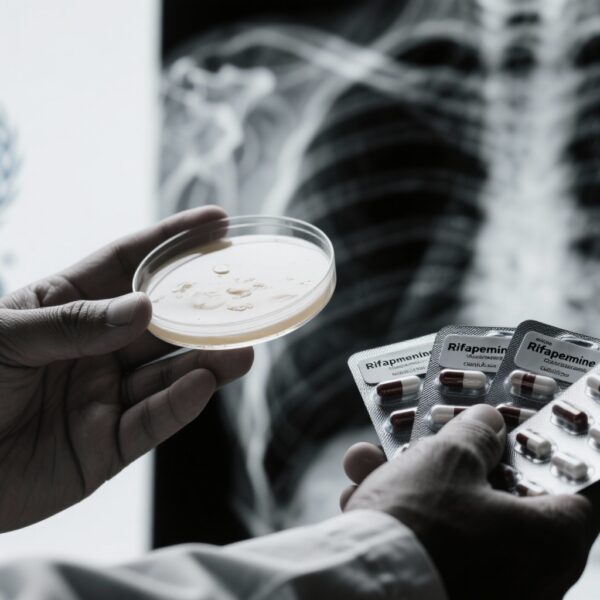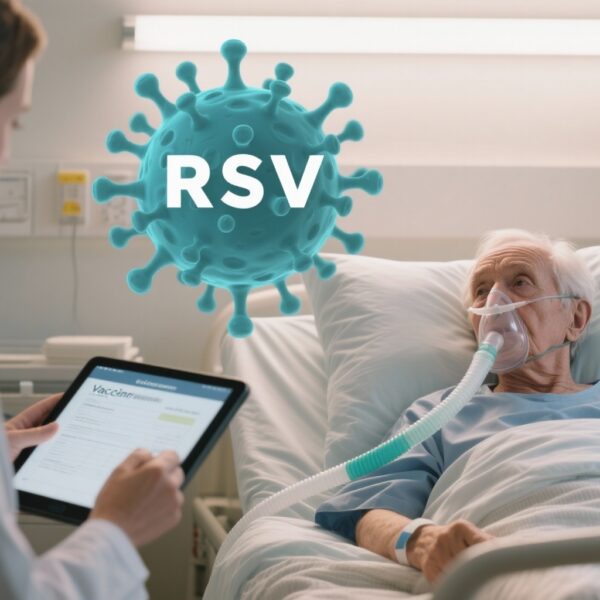Highlight
– In the single-centre, open-label VICTOR-CPA randomized trial (NCT04824417), oral voriconazole was not superior to itraconazole for treatment-naive chronic pulmonary aspergillosis (CPA) at 6 months.
– Clinical and radiological favourable responses were similar (69% voriconazole vs 67% itraconazole), while voriconazole produced significantly more treatment-related adverse events (55% vs 34%).
Background and disease burden
Chronic pulmonary aspergillosis (CPA) is a progressive, destructive fungal lung disease most commonly caused by Aspergillus fumigatus. It arises in patients with pre-existing pulmonary structural disease (notably prior tuberculosis, bronchiectasis, or emphysema) and causes chronic respiratory symptoms, cavitation, and progressive fibrosis. CPA is associated with substantial morbidity, impaired quality of life, and excess mortality when untreated or inadequately treated. International recommendations (European Respiratory Society/European Society for Clinical Microbiology and Infectious Diseases) endorse prolonged oral azole therapy as the cornerstone of medical management for most CPA phenotypes, with itraconazole and voriconazole commonly used agents (Denning et al., Eur Respir J 2016).
Study design and methods (VICTOR-CPA)
The VICTOR-CPA trial was a single-centre, open-label, randomized, controlled, superiority trial conducted at a tertiary chest clinic in Chandigarh, India. The investigators enrolled treatment-naive adults (≥18 years) with chronic cavitary pulmonary aspergillosis or chronic fibrosing pulmonary aspergillosis. Exclusion criteria included refusal of consent, prior azole exposure >3 weeks in the preceding 6 months, and other forms of aspergillosis.
Participants were randomized 1:1 to receive oral itraconazole 200 mg twice daily or oral voriconazole 200 mg twice daily for 6 months. Randomisation used a computer-generated sequence with variable block sizes. The trial used a modified intention-to-treat (mITT) population that included all participants who received at least one dose of allocated treatment. Primary outcome was the proportion achieving a favourable response (clinical and radiological stability or improvement) at 6 months. Safety analyses were conducted in the mITT population. Masking was partial: treating clinicians and participants were not blinded, but radiological reads were performed by a radiologist masked to clinical details and treatment allocation. The trial is registered at ClinicalTrials.gov (NCT04824417) and was funded by Cipla Pharmaceuticals, India.
Key findings
Between April 15, 2021 and May 31, 2024, 116 participants were randomized (58 to itraconazole and 58 to voriconazole). Mean age was 45.9 years; 64% were male. All randomized participants received at least one dose and were included in primary analysis.
Efficacy
The proportion achieving a favourable response at 6 months was essentially identical: 69% (40/58) in the voriconazole arm versus 67% (39/58) in the itraconazole arm. Absolute risk difference was −0.02 (95% CI −0.20 to 0.15), p = 0.84, indicating no evidence of superiority of voriconazole over itraconazole within the study population and follow-up period.
Safety
Voriconazole was associated with a higher rate of treatment-related adverse events: 55% (32/58) versus 34% (20/58) for itraconazole (p = 0.025). Adverse events were not fully enumerated in the summary data provided here, but the difference was statistically significant. There were four deaths, all occurring in the voriconazole arm; investigators judged none directly attributable to antifungal therapy.
Secondary and contextual findings
No superiority signal for voriconazole emerged despite its theoretical advantages: broader exposure, lower in vitro minimum inhibitory concentrations (MICs) for many Aspergillus isolates, and reliable oral absorption compared with older itraconazole formulations. The similar clinical outcomes observed likely reflect the complex interplay of host factors, disease chronicity, drug exposure at the site of infection, and antifungal tolerability over prolonged therapy.
Interpretation and clinical implications
The VICTOR-CPA trial provides randomized, prospective evidence that in a treatment‑naive Indian CPA population, oral voriconazole (200 mg twice daily) is not superior to oral itraconazole (200 mg twice daily) over six months, and is associated with a higher incidence of treatment-related adverse events. These findings support continued use of itraconazole as a first-line oral agent for CPA in similar clinical settings, with voriconazole retained as an alternative when itraconazole is poorly tolerated, drug–drug interactions prohibit itraconazole use, or susceptibility testing supports its use.
Why might similar efficacy occur despite differing in vitro potency?
Several factors can explain equal clinical outcomes: (1) Azole efficacy in CPA depends on sustained drug concentrations in cavitary lung tissue and pleural spaces; serum MIC differences may not translate to meaningful differences in local exposure. (2) Variability in oral bioavailability (particularly with itraconazole) can be mitigated by patient counseling (take with food) and therapeutic drug monitoring (TDM). (3) Host immune status, extent of structural lung disease, and pre-existing fibrosis drive clinical course and may blunt the incremental benefit of a more potent agent. (4) Adverse-event–driven interruptions reduce effective exposure; higher adverse-event rates with voriconazole may offset pharmacologic advantages.
Safety profile and monitoring considerations
The higher adverse-event burden with voriconazole aligns with established safety profiles: voriconazole commonly causes visual disturbances, photosensitivity, hepatic enzyme elevations, and neuropsychiatric symptoms. Long-term use is associated with phototoxicity and rare cutaneous malignancies. Itraconazole adverse events include gastrointestinal upset, hepatic toxicity, and congestive cardiac failure in susceptible patients. Both agents require baseline and periodic liver-function monitoring; voriconazole often prompts closer surveillance and early TDM because of nonlinear pharmacokinetics and variable metabolism (CYP2C19 polymorphisms).
Strengths and limitations of the trial
Strengths: randomized design, prospective follow-up, clinically relevant endpoint (clinical plus radiological improvement/stability), and blinded radiological assessment. The mITT approach preserved the pragmatism of including all dosed participants.
Limitations: single-centre setting may limit generalizability (clinical practice, comorbidity mix and microbial epidemiology differ across regions); open-label treatment could introduce performance and reporting bias for subjective clinical outcomes and adverse events; the 6‑month treatment and follow-up window captures medium-term outcomes but not longer-term relapse or durability of response beyond treatment cessation; details on therapeutic drug monitoring and fungal susceptibility testing (azole MICs) were not reported in the summary and would materially influence interpretation; the trial was designed as a superiority study, and absence of superiority does not prove equivalence—formal non-inferiority testing would require a different design and sample size.
Practical takeaways for clinicians
– Itraconazole (200 mg twice daily) remains a reasonable first-line oral agent for CPA in many settings, balancing efficacy, tolerability, availability and cost.
– Voriconazole should be considered when clinical circumstances favour its use (intolerance to itraconazole, documented itraconazole resistance, drug interactions, or prior treatment failure), but clinicians should counsel patients about higher likelihood of adverse effects and monitor more actively.
– Therapeutic drug monitoring is recommended where available for both agents to ensure adequate exposure and reduce toxicity; measuring trough concentrations can guide dose adjustments and interpret apparent treatment failures.
– Obtain fungal culture and susceptibility testing where feasible. Increasing azole resistance among Aspergillus fumigatus (driven in part by agricultural azole use) is an emerging concern and may mandate individualized therapy or combination/adjunct approaches.
Research and policy implications
Additional multicentre randomized trials with stratification by key factors (extent of disease, prior tuberculosis, host immune status), incorporation of TDM, and longer follow-up would further define comparative effectiveness and safety. Cost-effectiveness analyses contextualized to resource-limited settings (drug costs, monitoring infrastructure, and adverse-event management) would guide national formularies. Surveillance for azole-resistant Aspergillus spp. and routine susceptibility testing in treatment failures should be priorities for clinical laboratories and public health agencies.
Conclusion
The VICTOR-CPA randomized trial provides important, pragmatic evidence that oral voriconazole is not superior to oral itraconazole for treatment‑naive CPA at 6 months, while producing more treatment-related adverse events. These findings support continued preferential use of itraconazole as first-line oral therapy in settings similar to the trial site, with voriconazole reserved as an alternative guided by tolerance, susceptibility, and clinical context. Clinicians should combine antifungal choice with appropriate monitoring (liver tests, TDM where available) and microbiological stewardship to optimise outcomes for patients with this chronic and potentially debilitating disease.
Funding and trial registration
Funding: Cipla Pharmaceuticals, India. ClinicalTrials.gov registration: NCT04824417.
References
1. Sehgal IS, Agarwal R, Dhooria S, Prasad KT, Muthu V, Aggarwal AN, Rudramurthy SM, Garg M, Chakrabarti A. Oral itraconazole versus oral voriconazole for treatment-naive patients with chronic pulmonary aspergillosis in India (VICTOR-CPA trial): a single-centre, open-label, randomised, controlled, superiority trial. Lancet Infect Dis. 2025 Oct 29:S1473-3099(25)00537-7. doi: 10.1016/S1473-3099(25)00537-7. Epub ahead of print. PMID: 41175884.
2. Denning DW, Cadranel J, Beigelman-Aubry C, et al. Chronic pulmonary aspergillosis: rationale and clinical guidelines for diagnosis and management. Eur Respir J. 2016;47(1):45-68. doi:10.1183/13993003.00583-2015.



